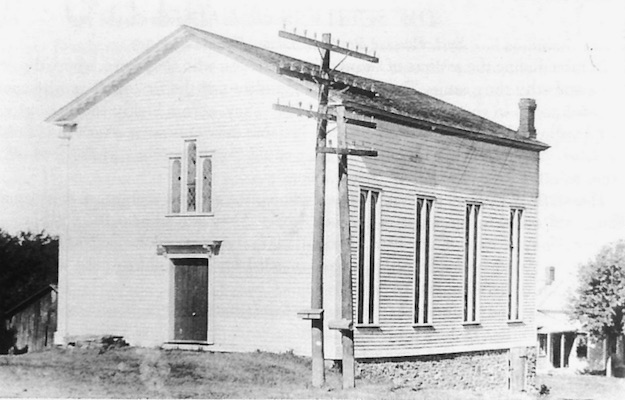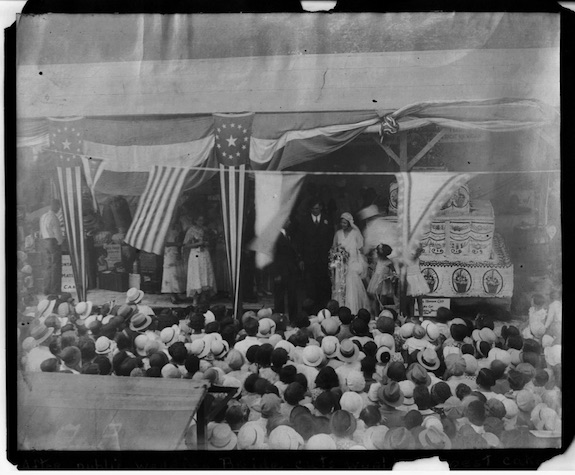Historic Childs: Stories from Church
Charles Howard, the Santa Claus School founder, also visionary behind ‘World’s Largest Cake’ that was served at a wedding
By Doug Farley, Cobblestone Museum Director – Vol. 2 No. 33
GAINES – The first church built between the Genesee and Niagara Rivers, located on the Ridge Road in the Town of Gaines, constructed in 1824, seen here circa 1920 when used by the Free Methodists. This church was remodeled in the 1870s and the second story windows were removed and replaced with the stained glass seen here. In later years, after being used as the Town of Gaines Highway Garage, it was demolished in 1991.
Churches have been present in the Town of Gaines and Hamlet of Childs since their earliest days. The Cobblestone Universalist Church built on land donated by John Proctor and the Gaines Congregational Church are two time-tested examples. While churches have always been regarded as solemn, religious institutions, we do find some examples in history where the solemnity of pondering mortal destinies was interrupted by some good, light-hearted, humorous situations.
One such humorous tale has survived its retelling since about 1837. A certain Mrs. Dewey, whom the youngsters called Mother Dewey, was a woman of positive character and was said to rule the roost of her home. She and her husband and daughter lived in a log cabin on the Gaines Basin Road, just south of the Ridge.
There was a berry patch that stood behind the home, a little garden around it, and a well of cold water shaded with birch trees was found near the door, and creeping over the doorway grew beautiful Morning Glories. The cold well was a temptation too strong to resist for the local boys who frequently refreshed themselves while on their berrying and nutting excursions. She enjoyed the boys’ company and was known to use the occasions to extract nuggets of gossip from the youngsters about all of the village residents.
The whole Town of Gaines knew her as a conscientious member of her church, where she was an unfailing attender, where she slept away much of her life. Locals remembered her well as she went down the road to the church. Though poor in the world’s goods, she was rotund in person and robust in health. She waddled along with head and shoulders held high and a big brown satchel slung over one arm. In church, her seat was in the back, under the overhanging gallery. There she sat and slept, with nodding head and mouth wide open, all the same whether the sermon was dull or awe inspiring.
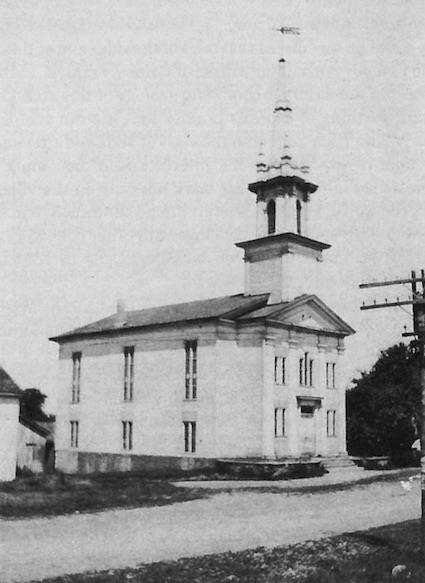
The first Gaines Congregational Church was built in 1834 and burned on Christmas Eve, 1950. Photo seen here circa 1915. It was also in 1834 that the First Universalist Society of Gaines erected the Cobblestone Church still present in Childs. This would suggest great religious fervor in the community at the time.
It was one summer Sunday, that Mother Dewey had taken her usual seat, had gone into her usual sleep, and the preacher had gotten well into the depth of his sermon, when two roguish boys in the gallery above discovered her head was directly under them thrown back unusually far, and a dark hole in her face where her mouth ought to be.
Like Adam and Eve, temptation got the best of them. Almost instantly, a fly-leaf from a hymnal was eschewed to pulp. It was held over her in hushed consultation and passed from hand to hand in trial. Finally it dropped! It was a plumb shot, a dead bullseye. She chocked, rolled over, coughed and spat the wad out. Her friends rushed to her side, opened the window, fanned her, propped her up and talked of apoplexy.
She said there was no apoplexy, nothing of the sort, but didn’t say what the matter was. Her dignity was fearfully insulted, and her indignation against unknown somebodies upstairs knew no bounds. In the melee, two boys made hasty tracks downstairs and out the doors, erupting in laughter heard all through the church. Visual correspondents later reported the boys were Newton Proctor and Oakley Ruggles who are said to have received sound thrashings from their angry parents.
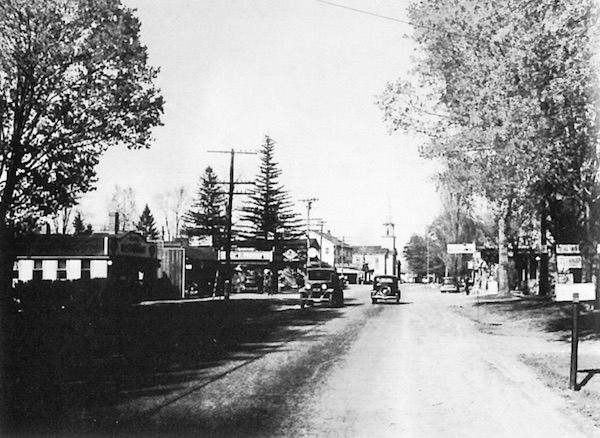
A view of Gaines looking east on Ridge Road, the Congregational Church steeple is seen in the center of the community. Burns restaurant is at the far left, it later became known as the Chatterbox.
Several years later, an older but wiser Mr. Ruggles, provided the inspiration for several other stories that add humor to local church life. Another such example was read at the Semi-Centennial Meeting of the Gaines Congregational Church on August 26, 1874. Ruggles tells of a certain Mr. Burnham who had an unusual, somewhat irregular, connection to the church. It seems he was allowed, whether knowingly or unknowingly, to stable his cow under the church, in an area that had been left open to the elements, through a gaping hole that had developed and had been left unattended over many years.
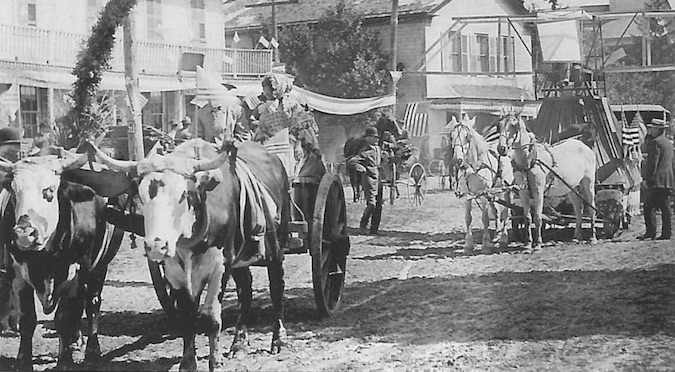
The Hamlet of Childs as seen in 1909 for the Centennial Celebration of the Town of Gaines, note the Village Inn at left, general store, center; and Cobblestone Universalist Church in the upper right corner of the photo. The general store was actually built as a cobblestone building, covered with stucco around 1870 and torn down in 1960.
This particular story involves a protracted evening revival meeting that was held in the church. People came from far around, and filled the house. The interest was great, and much good was being done, conversations were many, and folks lived better lives as a result. On one such occasion, when the house was crammed to suffocation, and after the clergyman had preached a fervent sermon, and given out a hymn, he called on repentant sinners to come forward to the altar for prayers.
In the midst of the tear-soaked singing and deep solemnity of the hour, Mr. Burnham’s two-year-old bull calf raised his voice. He started off on a high key as if sung by a coloratura soprano, then it modulated down to a crackling tenor and finished with a monotone droning bass, which performance he repeated several times to the outright dismay of the preacher, quite upsetting the gravity of the elders, on whose faces twinkled slight grins, while the youngsters reveled in downright belly laughter. The meeting ended early, and the bull-calf was summarily ejected from his lower berth, thus closing the chapter on Mr. Burnham’s pseudo-connection to the congregation.
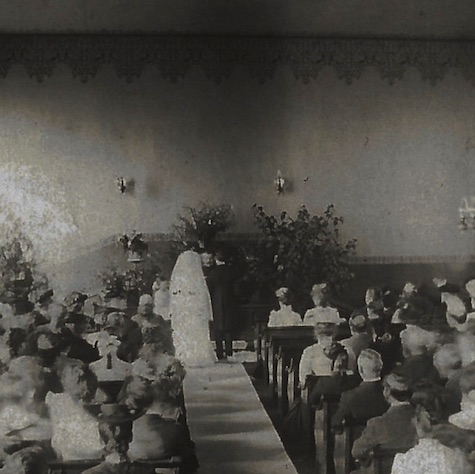
This photo, taken about 1890, shows a wedding in the old Gaines Congregational Church which burned on December 24, 1950.
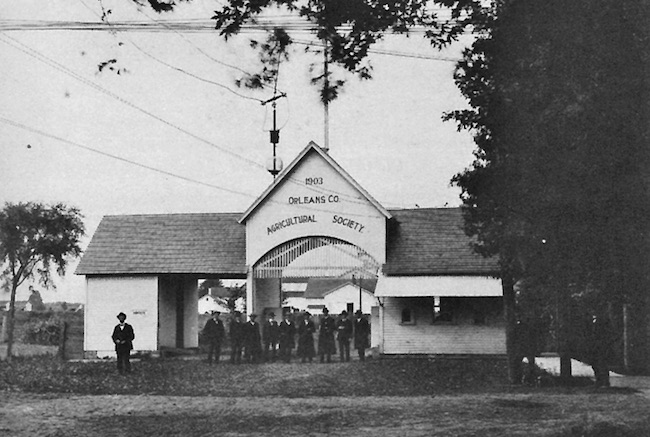
Entrance to the fairgrounds, early 1900s
Our last “church story” brings us forward to 1931, and isn’t actually a “church” story, because it didn’t take place in a church, but did involve a wedding. Over the years, the old Orleans County Fair had become a setting for couples to “tie the knot,” in outdoor ceremonies as part of Fair week.
In celebration of the Diamond Jubilee of the Orleans County Fair in that year, a decision was made to build the World’s Largest Wedding Cake. The cake, seen here at right, was baked by the Wehle Baking Company of Rochester under the supervision of John Woggon. The cake pieces were transported by truck to Albion and assembled on site.
Herman Thorschmidt, a champion cake trimmer, did the decorating. The 14-foot tall cake was topped with a sugar eagle. The base of the cake was 8’ square and was placed in a special building erected at the fairgrounds for the occasion. The recipe included 1,600 pounds of flour, 1,140 pounds of sugar, 910 pounds of shortening, 7,272 eggs, 455 quarts of milk, 1,000 pounds of applesauce, 100 pounds of baking powder, one gallon of vanilla, one gallon of lemon juice and 56 pounds of chocolate. The icing used 500 pounds of Confectioner’s sugar. The completed cake weighed in at 7,000 pounds.
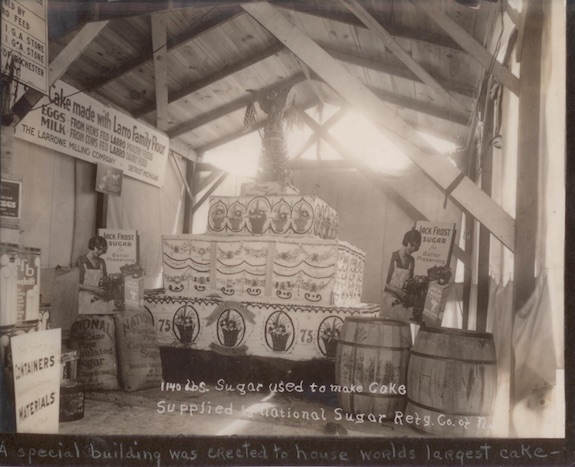
Photo courtesy Orleans County Historian
After the cake had been on display for several days, a public wedding was held next to the cake. The photo above shows the bridge and groom before their many spectators. The sign at the base of the cake stated, “This mammoth cake will be cut by the bride at 3pm.”
After the bride cut the cake, 5,000 slices were boxed and sold for ten cents each. It earned $500 and folks remarked how tasty the cake was. The entire spectacle was an example of the creative mind of legendary local, Charles W. Howard, who was credited with this “World’s Largest Cake” plan. Howard of course went on to “Santa Claus” fame with his world-famous Santa Claus School and Christmas Park.
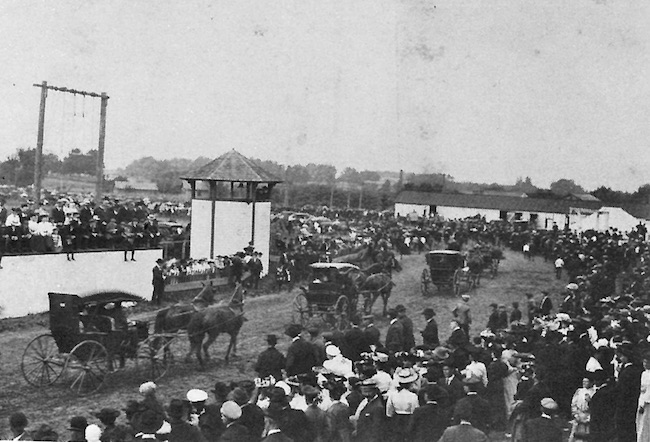
Fairgrounds, early 1900s
Howard’s successful “World’s Largest Cake” plan in 1931 was actually spurred on by an earlier success at the old Orleans County Fair. In 1929, the “World’s Largest Pie” was created, weighing 6,000 pounds. The dough was rolled out using the “World’s Largest Rolling Pin,” being four feet long and weighing 60 pounds.



















